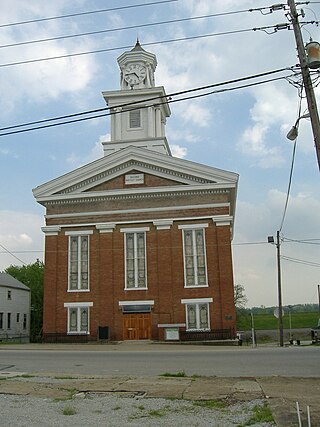
Old St. Mary's Church is a Roman Catholic church in Cincinnati's historic Over-The-Rhine neighborhood. It is the oldest continually-used house of worship in Cincinnati.

Atwater Congregational Church is a registered historic building in Atwater, Ohio, United States, listed on the National Register of Historic Places since February 23, 1973. It was built in 1841 and incorporates elements of both the Federal and Greek Revival styles and stands over 100 feet (30 m) tall. The church has had a continuous congregation that was founded in 1818 and continues to meet today as a non-denominational church. The building has undergone several renovations and repairs through the years.
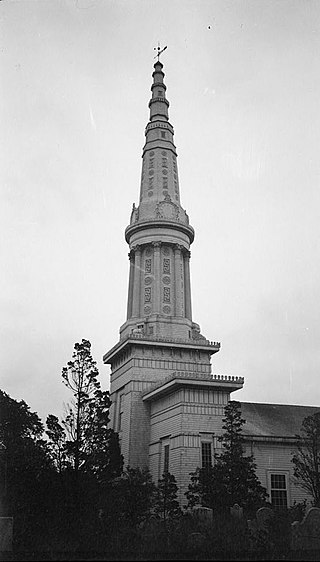
First Presbyterian Church in Sag Harbor, New York, also known as Old Whaler's Church, is a historic and architecturally notable Presbyterian church built in 1844 in the Egyptian Revival style. The church is Sag Harbor's "most distinguished landmark." The facade has been described as "the most important (surviving) example of Egyptian revival style in the United States," and "the best example of the Egyptian Revival style in the U.S. today.

The Fort Street Presbyterian Church is located at 631 West Fort Street in Detroit, Michigan. It was constructed in 1855, and completely rebuilt in 1877. The church was listed on the National Register of Historic Places and designated a Michigan State Historic Site in 1971. Its steeple stands 265 ft (81 m), making it one of the tallest churches in the United States.

First Presbyterian Church and Manse is a historic Presbyterian church located at West Madison Street and Park Avenue in the Mount Vernon-Belvedere neighborhood of Baltimore, Maryland, United States. The church is a rectangular brick building with a central tower flanked by protruding octagonal turrets at each corner. At the north end of the church is a two-story building appearing to be a transept and sharing a common roof with the church, but is separated from the auditorium by a bearing wall. The manse is a three-story stone-faced building. The church was begun about 1854 by Nathan G. Starkweather and finished by his assistant Edmund G. Lind around 1873. It is a notable example of Gothic Revival architecture and a landmark in the City of Baltimore.

The First Presbyterian Church in Batavia, New York, United States, is located at East Main and Liberty streets. It is a joined complex of several buildings. The main one, the church's sanctuary, is a limestone Gothic Revival structure built in the mid-19th century. Its congregation was the first church to be organized in Batavia, albeit as a Congregationalist group at that time.
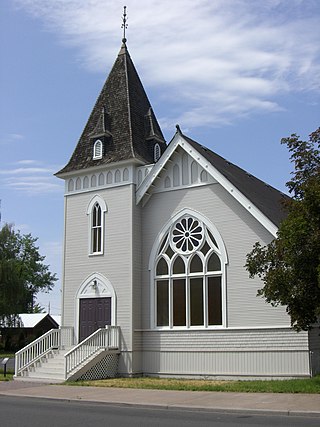
Built in 1912, the First Presbyterian Church of Redmond is the oldest standing church structure in the city of Redmond, Oregon, United States. It is also the second-oldest religious building in Deschutes County. The church was built in the Gothic Revival style with Queen Anne architectural detailing. It was the home of Protestant congregations from 1912 until 1979. Today, the building is privately owned and used as a special events venue. The First Presbyterian Church of Redmond was listed on the National Register of Historic Places in 2001.

The Francestown Meetinghouse is a historic meeting house on Route 136 in the center of Francestown, New Hampshire. The white clapboarded building was built c. 1801–03, and rebuilt in 1837, at which time it received its Greek Revival styling. It was used as a church until 1987, and for town meetings until 1833. The building was listed on the National Register of Historic Places in 1999. It is now managed by a nonprofit as a community resource.

First Presbyterian Church is a Presbyterian church in the city of Napoleon, Ohio, United States. Located at 303 W. Washington Street, it has been recognized as a historic site because of its unusual architecture.
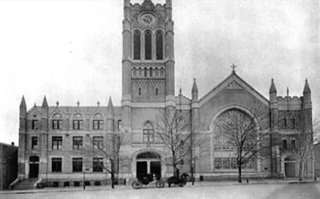
The congregation of North Presbyterian Church, at 525 West 155th Street in Manhattan, New York City, is a combination of three former congregations: North Presbyterian Church, Washington Heights Presbyterian Church, and St. Nicholas Avenue Presbyterian Church.
St. Joseph's Catholic Church is a parish church of the Archdiocese of Dubuque located in Elkader, Iowa, United States. The church and parish hall were both listed on the National Register of Historic Places in 1976.
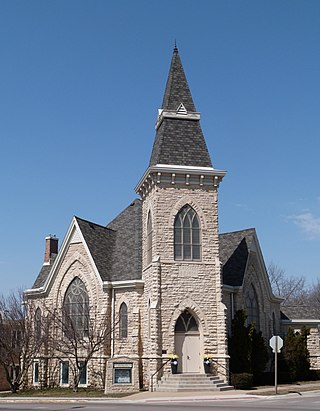
First Presbyterian Church is located in Marion, Iowa, United States. It was listed on the National Register of Historic Places in 1992.

First United Presbyterian Church is a historic church at 309 Lyon Street in Sault Ste. Marie, Michigan.

Sashabaw Presbyterian Church is a historic church located at 5331 Maybee Road near Clarkston, Michigan. The church is one of the oldest in the Detroit Presbytery and has served congregations for nearly 150 years. It was designated a Michigan State Historic Site in 1964 and listed on the National Register of Historic Places in 1980.

Aurora First United Methodist Church, also known as the First United Methodist Church of Aurora and Aurora Methodist Episcopal Church, is a historic Methodist church located at 304 Third Street in Aurora, Dearborn County, Indiana. It was built between about 1855 and 1862, and is a two-story, gable front, Greek Revival style brick building. It measures 45 feet, 6 inches, wide and 95 feet deep. A limestone front was added to the original building in 1903 and one-story rear addition built between 1885 and 1888. The church was remodeled in 1954.

First Evangelical United Church of Christ, also known as the Fifth Street Church and German Reformed Church, is a historic United Church of Christ church located at 111 Fifth Street in Aurora, Dearborn County, Indiana. It was originally constructed in 1848 as a Greek Revival style Baptist church. It was remodeled in 1911 in the Gothic Revival style. It is a one-story, red brick building measuring 40 feet, 6 inches, wide by 60 feet deep. It features arched openings and a projecting front tower topped by an octagonal spire. A parish hall was added to the church between 1932 and 1934. It is the oldest church building in Aurora.

St. Joseph Catholic Church is a parish of the Roman Catholic Church in Jasper, Dubois County, Indiana, in the Diocese of Evansville. It is noted for its historic church located at 1215 N. Newton Street.

Hopewell Presbyterian Church is a historic Presbyterian church located in Franklin Township, Johnson County, Indiana, United States. It was built in 1902, and is a two-story, Gothic Revival style Akron Plan design church. It is topped by an octagonal dome and features pointed arches, crenelation, and steeply pitched roof. A one-story hip roofed addition was built in 1927, and another one-story addition in 1958.

Downtown Aurora Historic District is a national historic district located at Aurora, Dearborn County, Indiana. The district encompasses 272 contributing buildings, 1 contributing site, and 3 contributing structures in the central business district of Aurora. The district developed between about 1830 and 1944, and includes notable examples of Italianate, Federal, and Greek Revival style architecture. Located in the district are the separately listed Aurora City Hall, Aurora Methodist Episcopal Church, Aurora Public Library, First Evangelical United Church of Christ, First Presbyterian Church, George Street Bridge, Hillforest, Lewis Hurlbert, Sr. House, Leive, Parks and Stapp Opera House, and George Sutton Medical Office. Other notable buildings include the T. and J.W. Gaff Distillery (1843), First National Bank (1924), I.O.O.F. Hall (1887), B&O Railroad Station (1911-1917), John Neff Building, Chamber Stevens & Co. Dry Goods Store, U.S. Post Office (1935), Star Milling Co. (1891), and St. John's Evangelical Lutheran Church (1874).




